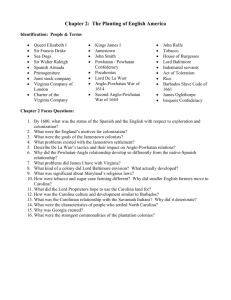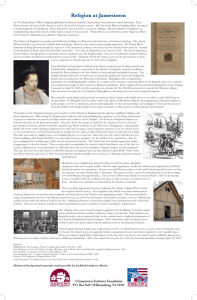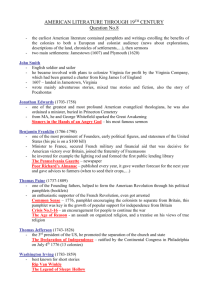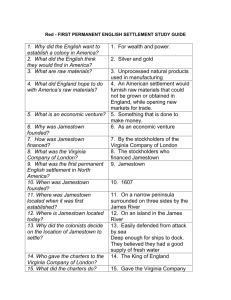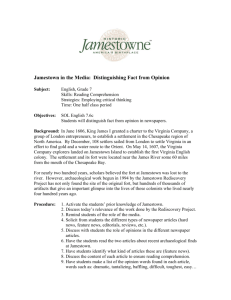Jamestown Timeline Early Settlement Years 1606, April James I of
advertisement
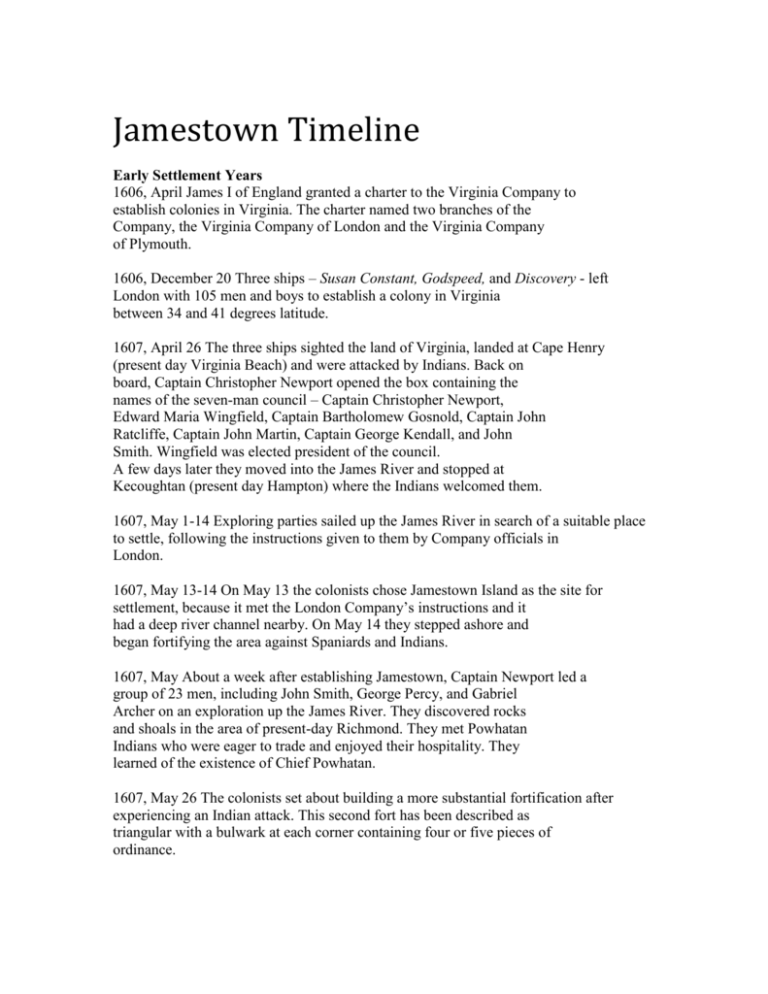
Jamestown Timeline Early Settlement Years 1606, April James I of England granted a charter to the Virginia Company to establish colonies in Virginia. The charter named two branches of the Company, the Virginia Company of London and the Virginia Company of Plymouth. 1606, December 20 Three ships – Susan Constant, Godspeed, and Discovery - left London with 105 men and boys to establish a colony in Virginia between 34 and 41 degrees latitude. 1607, April 26 The three ships sighted the land of Virginia, landed at Cape Henry (present day Virginia Beach) and were attacked by Indians. Back on board, Captain Christopher Newport opened the box containing the names of the seven-man council – Captain Christopher Newport, Edward Maria Wingfield, Captain Bartholomew Gosnold, Captain John Ratcliffe, Captain John Martin, Captain George Kendall, and John Smith. Wingfield was elected president of the council. A few days later they moved into the James River and stopped at Kecoughtan (present day Hampton) where the Indians welcomed them. 1607, May 1-14 Exploring parties sailed up the James River in search of a suitable place to settle, following the instructions given to them by Company officials in London. 1607, May 13-14 On May 13 the colonists chose Jamestown Island as the site for settlement, because it met the London Company’s instructions and it had a deep river channel nearby. On May 14 they stepped ashore and began fortifying the area against Spaniards and Indians. 1607, May About a week after establishing Jamestown, Captain Newport led a group of 23 men, including John Smith, George Percy, and Gabriel Archer on an exploration up the James River. They discovered rocks and shoals in the area of present-day Richmond. They met Powhatan Indians who were eager to trade and enjoyed their hospitality. They learned of the existence of Chief Powhatan. 1607, May 26 The colonists set about building a more substantial fortification after experiencing an Indian attack. This second fort has been described as triangular with a bulwark at each corner containing four or five pieces of ordinance. 1607, June 22 Captain Christopher Newport returned to England on the Susan Constant, loaded with wood and other natural resources for sale in English markets. 1607, Fall Over half the colonists died, most from disease and starvation, a few from wounds caused by Indians. 1607, December Captain John Smith, on an exploring and trading expedition, was captured by a Powhatan hunting party and eventually taken before Chief Powhatan, who by this time had become chief of about 32 Tidewater Virginia tribes. During this encounter, Smith thought Powhatan threatened his life, and Powhatan’s daughter, Pocahontas, saved his life. Many historians today believe that Smith was part of test of superiority. 1608, January 2 John Smith was released by Powhatan and returned to Jamestown. Captain Christopher Newport arrived with the first Jamestown resupply including provisions and more men. They found 38 settlers remaining at Jamestown. 1608, February Fire broke out in James Fort, causing much destruction. By spring, repairs had begun. 1606, Smith took Newport to Werowocomoco on the York River to meet Powhatan. Chief Powhatan pronounced the English to be his people. Thirteen-year old Thomas Savage was presented to Powhatan, and in return, Powhatan gave the English his servant, Namontack. The English traded copper and tools for corn. 1608, April 10 Newport sailed to England with Gabriel Archer, Edward Maria Wingfield and Namontack. 1608, September 10 Smith was elected to be president of the Virginia Council. He established a set of rules, one of which required men to work if they wanted to eat. 1608, September / October Christopher Newport arrived in Virginia with the second re-supply of goods and settlers, including the first two women, Mistress Forrest and her maid, Ann Burras. 1608, Fall Ann Burras and John Laydon, laborer, were married. This was the first English marriage at Jamestown. 1609 February- May Progress occurred in Jamestown - 40 acres were cleared, a well was dug, the church re-roofed, 20 cabins built, a blockhouse built at the isthmus, and a new fort erected across the river from Jamestown. Leadership adopted a more aggressive policy towards the Powhatan people. 1609, Spring Due to a shortage of food resources, John Smith scattered the settlers to get oysters and other foods. 1609, May The Second Charter was granted by James I to the Virginia Company, giving power to a governor rather than to a council in Virginia and allowing the Company to sell shares of stock. The first appointed governor was Lord De la Warr, but he did not arrive in Virginia until 1610. 1609, August A fleet with more than 300 new settlers arrived in Virginia. These men, women and children arrived tired and hungry. Their flagship, Sea Venture, carrying acting governor Sir Thomas Gates and other newly appointed colonial leaders, had shipwrecked in Bermuda. 1609, September John Smith was injured in a gunpowder explosion, and returned to England in October, never to return to the Chesapeake area of Virginia. George Percy became interim president until new leadership arrived. Gates/Dale Years 1610, Winter This winter is often called the “starving time,” when the population of Virginia shrank from about 300 to 90 (60 left at Jamestown). The Powhatan Indians placed the settlement under siege at this time. The siege warfare lasted about four years. 1610, May Acting governor Sir Thomas Gates and the other survivors of the Sea Venture arrived at Jamestown from Bermuda. He found the fort in ruins and the remaining 60 colonists there “famished at the point of death.” Gates established martial law to maintain order. 1610, June Due to lack of supplies, Gates decided to abandon the settlement at Jamestown and return to England. While sailing down the James River he heard that Lord de la Warr was arriving with new settlers and supplies from England. Everyone returned to Jamestown where Lord De la Warr soon assumed control as the appointed Governor of Virginia. Gates left for England. 1610, Summer De la Warr set about rebuilding the colony. He expanded the strict code of laws established by Gates. These became known as “Lawes Divine, Morall, and Martiall.” He rebuilt the triangular palisade, with a marketplace, storehouse and chapel occupying the interior. 1610, August English soldiers, at the command of Lord de la Warr, raided the Chickahominy and Paspahegh villages, killing the wife of the Paspahegh chief and her children. 1610-1611 John Rolfe, who arrived with the group from Bermuda, began experimenting with tobacco seeds he somehow acquired from the West Indies. He tried to find a tobacco more pleasing to English tastes than the bitter native tobacco that the Powhatans grew. 1611, March De la Warr became ill and returned to England with Dr. Lawrence Bohun, who experimented with New World plants and herbs. George Percy was left in charge in Virginia. 1611, May Sir Thomas Dale arrived in Virginia to assume leadership as deputy governor. With him were 300 new settlers and soldiers, as well as provisions, supplies, livestock and seeds to grow garden crops. He strengthened the rule of martial law. 1611, August Thomas Gates returned to Virginia and assumed control from Dale. Dale then went with workmen to build a new settlement at Henrico, near the fall line (present day Richmond), marking the beginning of expansion away from Jamestown. A settlement at Kecoughtan (later Elizabeth City / Hampton) also was established as settlers sought healthier places to live. 1612 The Virginia Company received a Third Charter from James I, granting more land to the Company, including the Bermuda Islands. This charter allowed the Company to run lotteries to raise money. 1612-1616 The Gates/Dale administration established Virginia as a going concern. Emphasis during this period was away from Jamestown as settlement spread. Relations with the Powhatan Indians were tenuous through 1614. 1613, April On a trading expedition to the Potomac River, Captain Samuel Argall kidnapped Pocahontas and brought her to Jamestown, hoping her father, Powhatan, would return stolen English settlers, tools and weapons. When her father did not fully comply, Pocahontas was sent to Henrico under the care of the Reverend Alexander Whitaker. 1613 The fourth Virginia Company “city” was established at Bermuda Hundred (later Charles City), following Jamestown, Henrico, and Kecoughtan. 1614 By 1614, John Rolfe had sent his first shipment of tobacco to England Pocahontas was baptized and given the Christian name Rebecca. In April, she married John Rolfe, probably at Jamestown. Peaceful relations were established temporarily between the Powhatan Indians and the English. 1614, Thomas Dale instituted the first semi-private grants of land to individuals in three-acre parcels; other land still was held communally. 1616, June Dale took Pocahontas and John Rolfe, with their infant son, Thomas, to England to promote investment in Virginia. Pocahontas was entertained at the court of King James I and Queen Anne. George Yeardley was in charge of Virginia. Growth and Stability 1616-1617 The rise of “particular plantations” or “hundreds” began. A year earlier, the Virginia Company, having no profits to pay its investors for their joint stock investments, began to grant land to private stockholding groups for settlement in Virginia. Anyone who owned a share of Company stock received 50 acres (would later be 100); anyone who came before 1616 was entitled to 50 acres (would later be 100); anyone who came after 1616 and paid his/her own way was also entitled to 50 acres (would later be 100). 1617 Pocahontas died at Gravesend, England. Rolfe left his son with an uncle in England and returned to Virginia. Captain Samuel Argall replaced George Yeardley as deputy governor. Lord de la Warr was still governor until his death in 1618. By this year, the fort was falling into ruins and was used primarily as a place of storage. 1618 Chief Powhatan died. Although his brother Opitchapam was officially the chief, his younger powerful half-brother Opechancanough took charge. A New Government 1619, April George Yeardley arrived to take his post as newly appointed governor of Virginia, with the mandate to implement new instructions which attempted to reorganize the Virginia Company’s activities in the colony,establish a plan of settlement and land reform, build a college at Henrico, and organize a legislative assembly. These instructions are often called “The Great Charter.” 1619, July 30 The General Assembly of the colony of Virginia, the first representative assembly (House of Burgesses) in English America, met in the church at Jamestown until August 4, 1619. The assembly adopted the Virginia Company’s instructions and passed some new laws. 1619, August The first recorded Africans arrived in Virginia. A privateering ship, White Lion, arrived at Cape Comfort (Point Comfort) carrying 20 or more Angolans. Treasurer arrived shortly thereafter with more Africans. They were sold to Governor George Yeardley and the cape merchant, who probably gave them the status of servants. 1620 Approximately 90 women (See the Bride Ship) arrived in Virginia to supplement those already in the colony, and to serve as wives for the planters. About 50 more arrived in 1621. 1621 The settlers, hoping to produce silk, planted mulberry trees to feed silkworms. They had little success. War and the Demise of the Virginia Company 1622, March 22 Opechancanough led the Powhatan Indians in an uprising, killing about one-third of the 1200 colonists in Virginia. Jamestown was warned and was not attacked, but survivors flocked to its fortification. Many outlying settlements were abandoned, and much sickness followed the uprising. 1622-1632 A period of intermittent warfare between English and Indians. 1623 The King’s Privy Council set up a commission to investigate the Virginia Company and conditions in Virginia. 1624 John Smith published his Generall Historie of Virginia, New-England, and the Summer Isles. 1624 ,Virginia became a royal colony. The Virginia Company was forced to yield its control to royal authority. King James I retained Governor Wyatt as the first royal governor. 1625, January A muster or census ordered by the Crown was taken, showing a total population of 1232 settlers and including numbers of weapons, livestock, grain, etc. ( See the next page for details)



